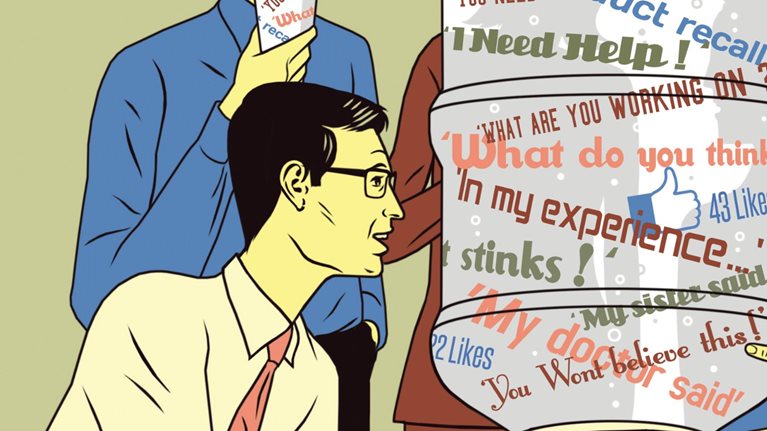Ever since companies began using the web to solicit ideas from outsiders for enhancing services and developing products, the promise of co-creation has overshadowed its measurable impact. Studies have shown that the impact of co-creation—the act of bringing external parties, usually customers or suppliers, into a company’s creative process—on new product innovation is neither statistically significant nor economically relevant, nudging the likelihood of success up by a scrawny 4 percent.1 While attempts to create products or services jointly may produce desirable side effects—in the form of reduced market-research costs or increased customer loyalty—the ultimate goal of bringing outstanding products to the market remains elusive.
While co-creation with customers has produced widely publicized successes at some brand-name companies, the challenges that practitioners must overcome to build and sustain a productive model of online collaboration have been minimized, if not ignored. That oversight should be corrected. Co-creation skills are an important capability for companies, requiring agile processes, quick test-and-learn cycles, and a deep understanding of customers. In fact, in contrast to the average practice, the masters of co-creation not only unlock value rapidly by delivering high-quality products and service innovation but also sustain that impact over time—all with little additional R&D overhead.
Last year, we studied more than 300 companies in three European countries and found that the best at co-creation excelled in three areas:
1. Target your co-creators
Our research found that while 90 percent of executives were eager to get consumers involved in co-creation, only 12 percent of Internet users had actually done so. In fact, only a quarter of consumers were even aware of the concept, while an additional 5 percent knew about co-creation but not how it actually worked. To overcome this issue, the best companies parse customer data to actively target co-creators and actively explain how to use their co-creation platform. They segment their audience and tailor marketing promotions to what appeals to users: for example, games, money, education, or pure peer recognition.
Since 2001, for example, P&G has successfully been bringing outsiders into its R&D process. As well as targeting them by motivation, the company has also targeted retirees with specific skill sets, including P&G’s own alumnae, as well as retired technical specialists at airline companies.2 P&G’s co-creation platform, Connect + Develop, has spawned dozens of products, boosted product development, and effectively doubled the number of employees engaged in R&D—without adding to payroll costs.
Implicit in this effort is getting to critical mass: without enough people, the chances of co-creation success drop. When Starbucks launched its My Starbucks Idea co-creation platform for customers, it understood from the start that it was critical to lure big numbers of participants—between 1,000 and 7,000 is an ideal number for one product.
An important element of successful recruiting is finding people who actually like your brand. Finding people on social media who not only “like” your brand but are also active promoters is a good place to start. In addition, the value benefit can increase. Our research shows that a brand’s market share is more than twice as correlated with those who are inclined to co-create with a brand than with those who only make positive comments on social media.
2. Find the motivation
Getting a critical mass of users to do more than drop by and glimpse an online co-creation platform can be daunting. Having clear navigation and communications is critical so that potential co-creators know what kind of help you’re looking for. Co-creation-savvy companies list their needs and organize them by category, mimicking online co-creation platforms such as O’Desk or Mechanical Turk.
Understanding and tapping into what motivates co-creators is critical for getting them to submit good ideas. Not surprisingly, one motivation is compensation. Heineken launched its co-creation platform in 2012, asking game lovers, beer drinkers, and environmentally conscious consumers for ideas that would make its packaging more sustainable.3 The winner, a German citizen, suggested a device (the Heineken-o-Mat) intended to turn recycling into a game and walked away with a $10,000 prize.
Yet interestingly, many people aren’t motivated to co-create purely by compensation. Our research on ten co-creation projects found that the largest percentage of participants (28 percent) was driven by curiosity and a desire to learn, followed closely by entertainment and social play (26 percent), and an interest in building skills (26 percent). Some 20 percent were driven by recognition and rewards.
Starbucks, for example, fostered an atmosphere that welcomed the opinions and reviews of customers, and provided a platform for them to connect with each other. By talking to each other and to the company, customers shared views on store design, in-store music, and corporate social responsibility initiatives. The most active of the 250,000 participants in the first two years4 received recognition on the site; some also got the ultimate reward of their idea being among the 300 that the company has implemented.
It’s important to bear in mind the segments of co-creators—such as gamers and social butterflies—and then design applications with them in mind. For example, creating a fun contest will draw game lovers. Building in a social component, such as a leader board for winning games, is also likely to entice people who want social recognition. But what really generates mass participation is when companies attract audiences to co-creation with multiple appeals. A contest to draw game lovers is also likely to entice people who want social recognition (by winning games), for example.
3. Focus on a sustainable payoff
For co-creation to pay off handsomely over time, companies must focus it on activities that deliver a sustainable competitive advantage.
That may be about being a price leader, a product innovator, or superior service provider. P&G has used co-creation to remain an innovator in household cleaning products. Ideas from its product-co-creation program have helped it turn its Febreze air-freshener brand into a fragrant frontrunner, with $1 billion in annual sales. Threadless, a company that manages and sells crowd-sourced tee shirt designs, built a sustainable model by producing high-quality shirts in limited quantities to create the sense of a premium brand.
Other companies have rightly rooted co-creation on creating a cost advantage. Take Chinese motorcycle maker Loncin. In the late 1990s, the firm needed to become more price competitive with Honda, Yamaha, and Suzuki in the Vietnamese market. Loncin brought suppliers rather than customers into its co-creation initiative and asked for ways to reduce the cost of manufacturing. The resulting ideas helped Loncin cut costs by more than 70 percent and gain 60 percent of the Vietnamese motorcycle market within four years. With strong capabilities in co-creation, Loncin since has branched out into engines and cars.
Similarly, Missha, a 14-year-old cosmetics retailer based in South Korea, turned to co-creation in the early 2000s to create a lower-priced yet attractive alternative in a market dominated by high-priced brands. Missha appealed to its suppliers to help reduce costs without stripping away valued capabilities. The feedback helped Missha more than double its market share in South Korea.
Co-creation is here to stay. For companies that figure out how to do it well, the rewards can be far greater than a more effective and efficient R&D organization. More important, it is a core capability for unleashing the vast ingenuity of outsiders on an organization’s biggest challenges.


